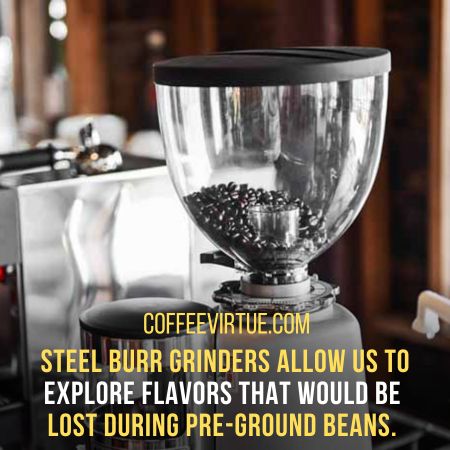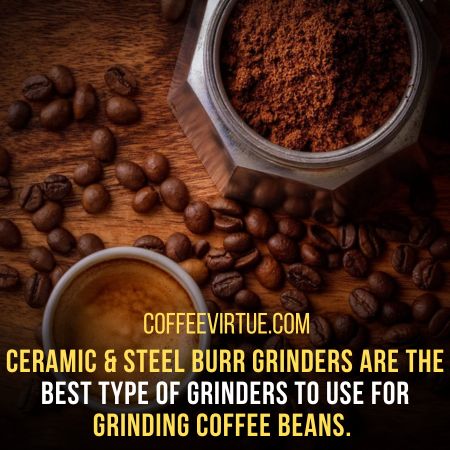When choosing between ceramic vs. steel burr grinders, it is important to consider both the budget and what type of grinding you plan on doing.
What Will I learn
In this article, you’ll learn the difference between both burr grinders. You’ll learn the advantages and types of these grinders.
Ceramic Vs. Steel Burr Grinders
You must decide whether to get a ceramic or steel burr grinder when grinding coffee beans.
Both types of grinders have their advantages and disadvantages. It’s important to weigh the pros and cons before making your purchase.
Ceramic burr grinders are known for their durability and strength. They can withstand heat much better than stainless steel grinders.
This makes them ideal for long-term use in commercial settings. On the other hand, steel burr grinders are more affordable and come in various styles.
They tend to be quieter than their ceramic counterparts. It makes them better for home use where noise levels may be an issue.
Here is the complete difference between ceramic and steel burr grinders:
Ceramic Burr Grinders
Ceramic burr grinders are a type of coffee grinder that use ceramic burrs instead of blades. They produce a more consistent grind than blade grinders.
It allows for better extraction and flavor from your coffee. Ceramic burrs last longer than steel or other materials used in conventional grinders.

It makes them a great investment for the home barista. The adjustment mechanism on these grinders is usually an external wheel or knob.
It allows you to adjust the size of the grounds produced easily. With precise control over grind size, you can experiment with different brewing methods.
Types of Ceramic Burr Grinders
Ceramic burr grinders are an essential tool for preparing delicious cups of coffee. They come in various types, each with unique advantages and disadvantages.
Here’s a look at the most common types of ceramic burr grinders:
1. Flat Burr Grinder:
A flat burr grinder comprises two matchings and flat plates with sharp edges. It is used to crush beans into smaller pieces.
It is known for producing consistent grinds without too much heat buildup. It preserves more flavor from the beans.
The downside is that it can be slow-going and sometimes produce inconsistent results. It is due to its slower speed.
2. Conical Burr Grinder:
A conical burr grinder has two cone-shaped plates with sharp edges. They are designed to crush the beans.
The shape of the burrs allows for a greater area of contact and more precise control over the grind size.
This makes it excellent for producing consistent results. However, it may still be prone to heat buildup due to its faster speed.
3. Rotating Burr Grinder:
A rotating burr grinder features two helix-shaped plates. These rotate against each other to crush the beans into smaller pieces.
This type is known for producing consistently sized grinds. It can generate a lot of heat, affecting the flavor of your final cup of coffee.
4. Hybrid Burr Grinder:
A hybrid burr grinder combines the benefits of a flat and a conical burr grinder. It offers both speed and consistency in grinding.
Coffee professionals use this type. It produces the highest quality grinds possible.
The downside is that it can be expensive and require more maintenance than other types.
Advantages of Ceramic Burr Grinders:
Cerami burr grinder provides numerous benefits. These benefits make them more reliable than other types.
Here are common advantages of ceramic burr grinder:
1. Durability:
Ceramic burr grinders are extremely durable. They can last for many years with proper maintenance.
Unlike metal-burred grinders, ceramic burrs will not become dull or replaced. It ensures consistent coffee grounds for a long time.
2. Even Grinds:
Ceramic burr grinders provide much more even and consistent grinding. It results without producing too much heat.
It would otherwise damage the coffee beans’ flavors and aromas. By grinding the beans even, users can achieve better extraction.
It gives a better taste than their brewed coffee.
3. Control Over Grind Size:
Ceramic burrs give users complete control over the size of their grinds.
The grinder can be adjusted depending on the user’s needs and preferences. They can help to produce finer or coarser particles.
4. Low Noise:
One of the biggest advantages of ceramic burr grinders is that they don’t produce much noise.
This makes them ideal for places where noise needs to be minimal. Places such as offices, cafes, and homes with small children asleep nearby.
5. Cost-Effective:
Despite their many benefits, ceramic burr grinders are often more affordable.
It is due to the materials used in construction and the technology used to create them.
This makes them great for those on a tight budget. They provide high-quality results from their coffee.
Steel Burr Grinders
Steel burr grinders are essential for coffee connoisseurs who want to get the most out of every cup.

By grinding their beans, users can control the size and consistency of their grounds.
It allows them to explore flavors that would be lost during pre-ground beans. Steel burr grinders are especially renowned for producing an even particle size.
They are crucial in achieving a consistently balanced brew each time you make it. The steel blades tend to last longer than other materials.
It makes them a smart choice for those looking for an investment grinder that will stand up over time.
Types of Steel Burr Grinders:
Steel burr grinders are popular for those looking to get the most flavor and aroma out of their coffee.
Here’s a look at the different types available:
1. Flat Burrs:
Flat burrs are one of the most common types of grinder used in home espresso machines. They are more affordable than ceramic or conical burrs.
Their shape means your coffee won’t get as evenly ground as other types.
They are also more prone to clogging, and the grind size can vary slightly due to their shape.
2. Conical Burrs:
Conical burrs are designed with two cone-shaped pieces that fit together. It allows them to provide a very consistent grind size.
This type of grinder is ideal for those who want a uniform grind. It allows you to enjoy coffee without spending too much on a high-end burr grinder.
3. Blade Grinders:
Blade grinders use blades rather than burrs to grind coffee beans.
It results in inconsistent grind size and often leaves some half-ground particles behind.
For this reason, they are not recommended for espresso or other methods that need fine ground.
However, they can be useful if you’re looking for a quick and easy way to grind small amounts of coffee at home.
Advantages of Steel Burr Grinders:
Steel Burr Grinders are a great choice for those who grind roasted coffee beans at home. They provide many advantages over other types of electric grinders.
Here are the advantages of a steel burr grinder:
1. Consistency:
Steel burr grinders provide a consistent grind size. It allows for more controlled and accurate espresso extraction.
The grounds’ uniformity ensures that all brewed coffee has balanced flavors.
2. Durability:
Steel burr grinders are incredibly durable. They will withstand many years of use without showing any wear or tear.
This makes them ideal for those who ensure their investment in a grinder lasts for the long term.
3. Versatility:
Steel burrs are fully adjustable. It means they can be used to create fine-tuned results from espresso brewing.
This makes them incredibly versatile and can create any grind size you need.
4. Cost-Effective:
Steel burr grinders tend to be more affordable than other types of espresso grinders. It makes them a great choice for those on a budget.
They also need less maintenance over time than other espresso grinders. It can help reduce overall costs even further.
Ceramic Vs. Steel Burr Grinders – Which Is Better & Why?
There are two major options when choosing the right grinder for your coffee. One is ceramic, and the other is steel burr grinders.
Both types can provide a consistent grind size important for flavor extraction. But which one should you choose?
Ceramic burr grinders offer greater heat stability than steel burrs. It makes them less likely to damage the beans during grinding.
They require less energy to operate compared to steel models, allowing you to save money in the long run.
On the other hand, ceramic burrs tend to be more expensive than their steel counterparts. They require more frequent cleaning due to their porosity.
Steel burr grinders are durable and need less maintenance than their ceramic counterparts.

They are also more affordable, making them a better choice for those on a budget. However, the potential to overheat beans is greater with steel burrs.
They tend to operate at higher RPMs. Additionally, metal particles can sometimes contaminate the coffee during grinding.
In conclusion, ceramic and steel burr grinders have their advantages and disadvantages.
The best choice depends on your individual needs and preferences and your budget.
Conclusion:
The choice between ceramic and steel burr grinders boils down to personal preference.
Ceramic grinders are better at maintaining an exact size of coffee grounds for a consistent flavor.
In contrast, steel grinders offer more consistency in particle size and greater durability. For those on a budget, steel may be the way to go.
However, those prioritizing high-quality espresso should consider investing in a ceramic grinder. Ultimately, deciding which type best suits your needs is up to you.